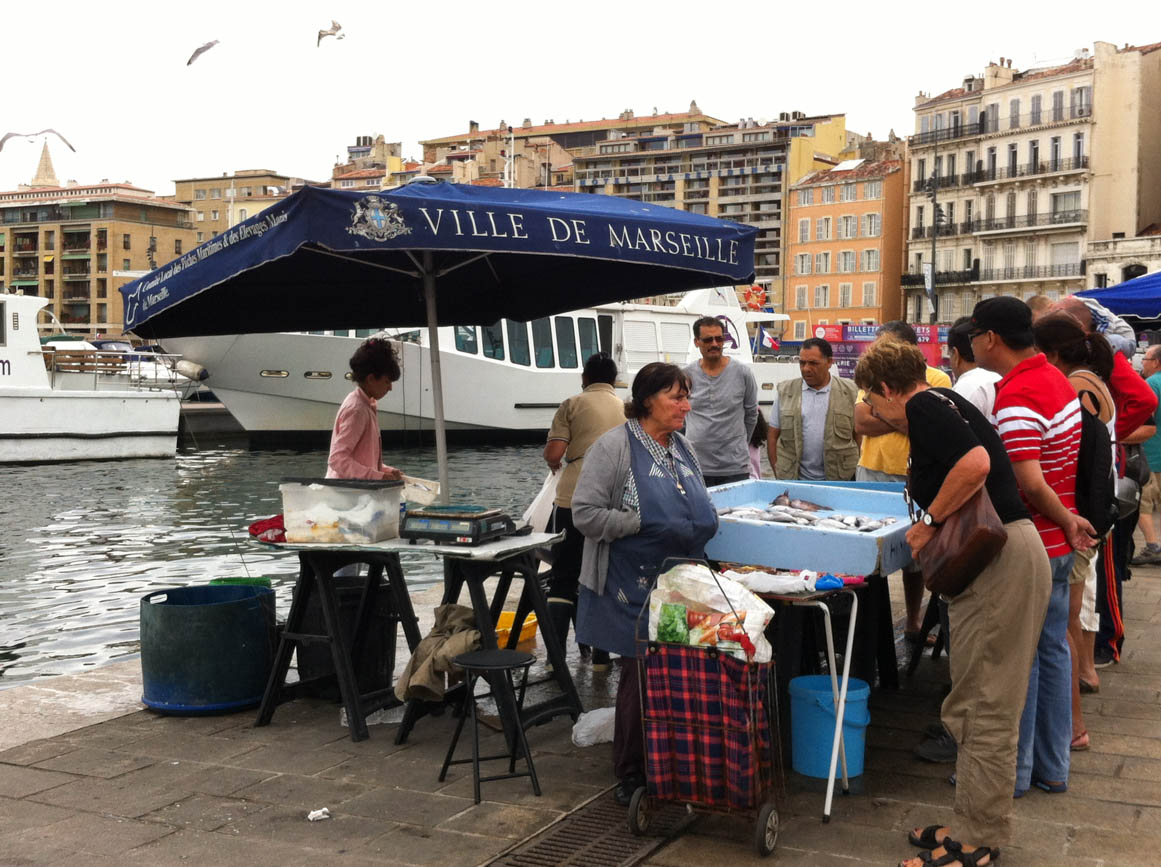
Things to do in Marseille, the Mediterranean capital of the Provence–Alpes–Côte d’Azur region
As the second largest city in France, Marseille exudes its unique personality around every corner. With its vibrant and ancient port by the Mediterranean Sea and surrounded by a gleaming coastline, imposing landmarks and welcoming people, you will soon understand why this town has transitioned from an underrated destination to a must-visit in the country. In this travel guide, I’ll walk you through everything you need to know to plan your trip, from the top 10 things to do in Marseille, to what and where to eat, where to stay and some day trip ideas. At the end of this post, I’ve also included a map so you can easily pinpoint all the locations mentioned here. Bienvenue à Marseille!
***
Disclaimers:
- This post was originally written following my work trip to Marseille in June 2014, when I was living in Washington DC and flew through Frankfurt. This update reflects the latest information available to this date.
- Please note that this post includes some affiliate links. This means that, at no additional cost for you, I earn a commission if you make a purchase. In case you have any question about the companies advertised here or my status as an affiliate, please do not hesitate to contact me.
***
Throughout the trip, I used this France travel guidebook, as well as this other guide with France´s best road trips, both by Lonely Planet, to plan our stay and make the most out of it. I hope you’ll find them helpful too!
Historic background
Originally founded as an ancient Greek settlement called Massilia in the 7th century BC, the city of Marseille was then taken by the Romans in 49 BC. Thanks to its vibrant port, it soon became the main gateway of the Mediterranean to trade and exchange goods. Sadly, following the last plague epidemic in France in 1720 , the population of Marseille was decimated. Later on, during the French Revolution, the famous ´La Marseillaise´ that originated as a battle song would end up becoming the national anthem of the country.
Traditionally considered the flip side of the glamorous French Riviera because of its industrial and crime-ridden past (it is sometimes described as the Rio de Janeiro of Europe), Marseille is finally enjoying a well-deserved renaissance since it was elected the European capital of culture in 2013. Nowadays, Marseille hosts a population of over 1.6 million and is the capital city of the Bouches-du-Rhône département in southern France. It is also the administrative and commercial capital of the Provence–Alpes–Côte d’Azur region.
Explore these cities and areas in France.
Given its past as a crossroads of immigration and trade, the ancient city of Marseille exudes a unique personality and has served as an inspiration for both French authors (take Alexandre Dumas and his novel ‘The Count of Monte Cristo’ or Marcel Pagnol, for example) or television series (such as ‘ Marseille‘ starring Gérard Depardieu on Netflix).
In terms of the weather in Marseille, the city enjoys cool-mild winters with moderate rainfall as well as hot summers that are typical of the Mediterranean climate. That being said, the general constant in town is the Mistral wind.
Another thing that you should be aware of is that locals are huge supporters of their football club, namely Olympique de Marseille (OM), which plays in the Orange Vélodrome stadium. And I can tell you that the rivalry with other French teams such as Paris Saint-Germain (PSG) is real! Still on a sports note, the Open 13 Provence is a tennis ATP tournament that usually takes place in Marseille for one week in February.
Top 10 things to do in Marseille
Thanks to its rich history, melting pot of cultures from Africa to the Middle East and beyond, vibrant markets and ancient port, Marseille is a city both captivating and exotic where you could easily spend two or three days. While walking around, you will certainly discover its unique personality.
Listed below in aplhabetical order are the top ten things to do in Marseille, France:
- Basilique Notre-Dame-de-la-Garde
- Beaches in Marseille
- Boulevard Canebière
- CGM Tower
- Fort de St-Jean and Fort St-Nicolas
- Hôtel du Département
- La Cité Radieuse
- Le Panier
- Musée des Civilisations de l´Europe et de la Méditerranée (MuCEM)
- Vieux Port
Now, let’s see all these attractions in more detail!
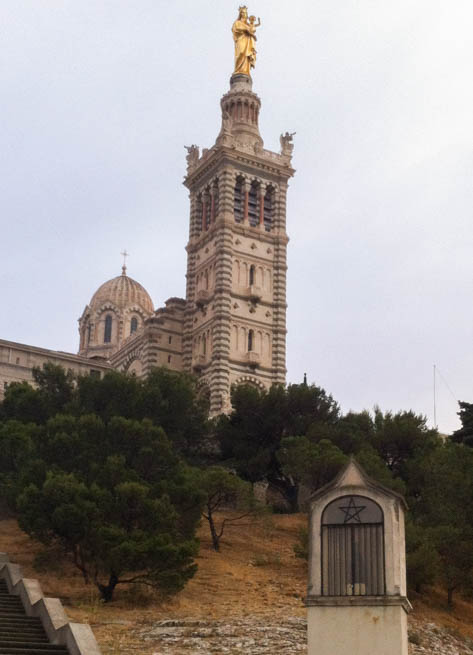
Basilique Notre-Dame-de-la-Garde
This Romanesque-Byzantine basilica (Basilique Notre-Dame de la Garde, also known among locals as ‘la Bonne Mère‘ or Good Mother) overlooks the city and the Mediterranean coastline. It’s no doubt one of the top attractions in Marseille! That being said, walking up the steep streets to reach this perched temple can take quite some time and effort. It actually reminded me of the hills in San Francisco! 🙂 Alternatively, you can take the bus (line 60).
Built between 1853 and 1864, the bell tower of Notre-Dame de la Garde is topped by the iconic golden statue of the Virgin and its interior is profusely decorated in colored marble and mosaics. You can also book a panoramic visit if you’d like to enjoy breathtaking views.
Other religious temples in Marseille include the fortified church of Abbaye Saint-Victor, Cathédrale de la Major, Église des Réformés (Saint-Vincent-de-Paul), or Église Saint-Laurent.
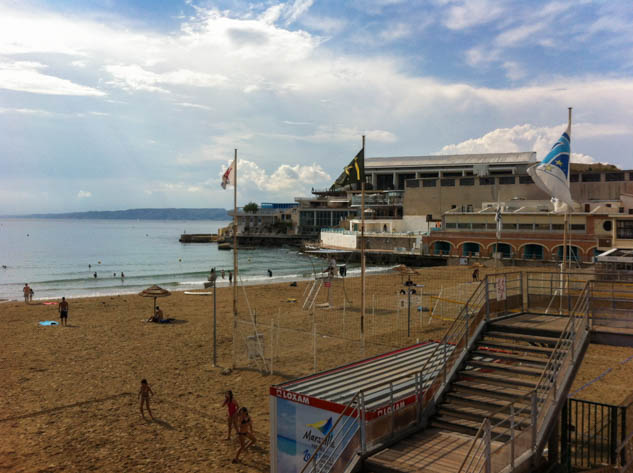
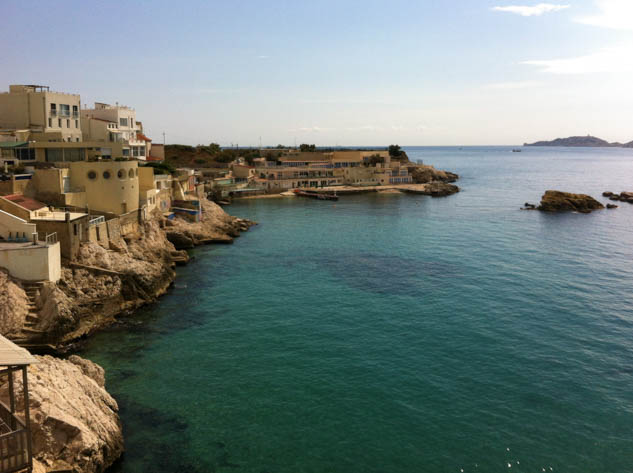
Beaches in Marseille, France
Given the pleasant Mediterranean climate you will find in Marseille, there are a number of beaches you could take a dip in during your stay in the city. Listed from west to east, write down these beaches in Marseille in case you have some spare time: Plage de la Lave, Plage des Catalans, Plage du Prado, Plage du Prophète, Plage de l’Huveaune, Plage de la Pointé Rouge, Plage le Bain des Dames.
In case you feel like exploring beaches and coves beyond Marseille, read my suggested day trips at the end of this post, including the Calanques National Park (Parc National des Calanques) or the glamorous French Riviera.
Boulevard La Canebière
Located in the old quarter of Marseille known as Le Panier, this historic 1-km long boulevard is lined up with trees as well as elegant buildings from the 17th and 18th centuries. It connects the Vieux Port with a church (Église des Réformés) and is the bustling shopping heart of the city.
CMA CGM Tower
The imposing skyscraper housing the headquarters of the CMA CGM freight company dominates the skyline of Marseille. Designed by the Iraqi-British architect Zaha Hadid and completed in 2011, this 147-meter tall tower is located in Euroméditerranée, the modern business district of Marseille (France).
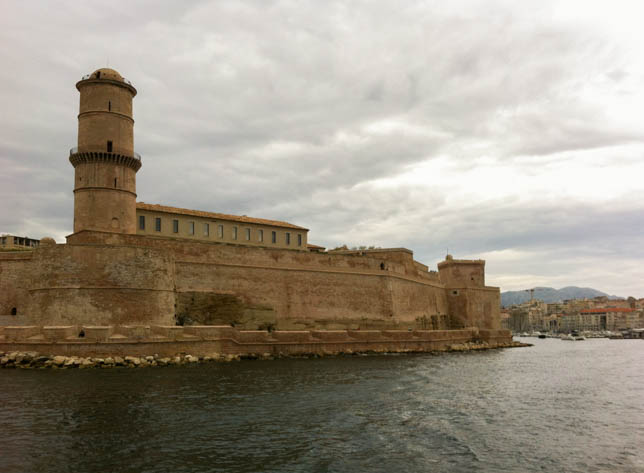
Fort de St-Jean and Fort St-Nicolas
Back in the day, these two forts used to guard the Vieux Port. On the one hand lies Fort Saint-Nicolas (also known as Citadelle de Marseille), a fortress or citadel built in the 17th century, while on the other hand you will find the more ancient Fort Saint-Jean, constructed in the 13th century by the Order of Knights of the Hospital of Saint John of Jerusalem. From the Fort Saint-Jean, you can walk the footbridge connecting this historic landmark to the modern MuCEM museum.
Hôtel du Département
This bright blue structure suspended on pillars and designed by British architect Will Asop houses the Marseille county government office.
Other civil and cultural landmarks worth checking out include the City Hall (Hôtel de Ville), the Hôtel de Préfecture des Bouches du Rhône built in 1866 near the Vieux Port, the Maison Diamantée (a house with a remarkable facade of pointed stones) or the Palais de la Bourse.
La Cité Radieuse
If you’re passionate about architecture, one of the best things to do in Marseille is visiting this post-war urban complex designed by Le Corbusier known as the Radiant City. The modern landmark of La Cité Radieuse, which is listed as a UNESCO World Heritage Site, is definitely a must-see.
Le Panier
Literally meaning ‘ basket’ in French, Le Panier is the Old Town of Marseille (France). This historic quarter encompasses colorful, narrow streets covered in graffiti, unique shops and neighborhood cafes. Some of the most charming squares and streets in Le Panier include Place de Lenche, Place des Moulins, Place des Pistoles, Rue du Petit-Puits or Passage Lorette.
Thanks to its bohemian atmosphere, it is known as the Montmartre of Marseille, in reference to the iconic neighborhood in Paris.
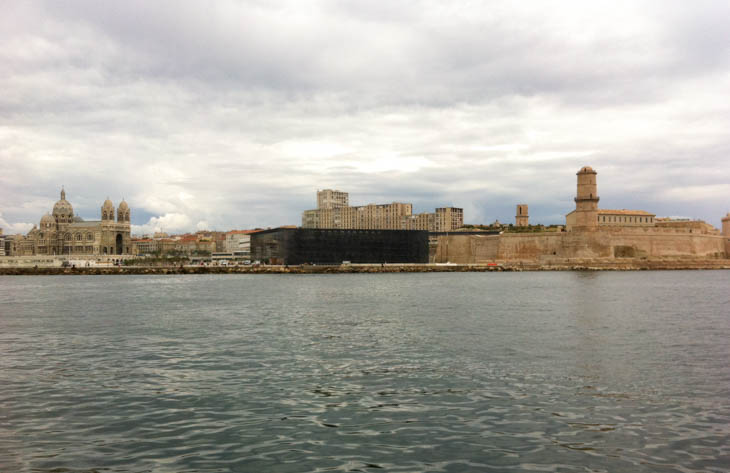
Musée des Civilisations de l´Europe et de la Méditerranée (MuCEM)
The Museum of Civilizations of Europe and the Mediterranean (Musée des Civilisations de l´Europe et de la Méditerranée or MuCEM) was inaugurated in 2013. Its enormous anthropological collection is housed in a striking building known as J4, designed by French architect Rudy Ricciotti. A modern footbridge connects the museum to the historic Fort Saint-Jean mentioned earlier.
Some other museums in Marseille worth mentioning include Centre de la Vieille Charité (a former almshouse now turned into a museum and cultural center displaying Egyptian artifacts, among other objects), Marseille History Museum (MHM), Musée des Beaux-Arts (MBA, located in the Palais Longchamp), Musée des Docks romains (showcasing the Roman maritime trading past of the city), Musée du Savon de Marseille (devoted to the famous local soap), the Museum of Contemporary Art (MAC) or a prehistoric cave (Grotte Cosquer).
Other cultural venues you may also want to stop by are the art deco opera house inaugurated in 1685 (Opéra de Marseille), the congress center (Palais du Pharo), or the national theater of the city (Théâtre de La Criée).
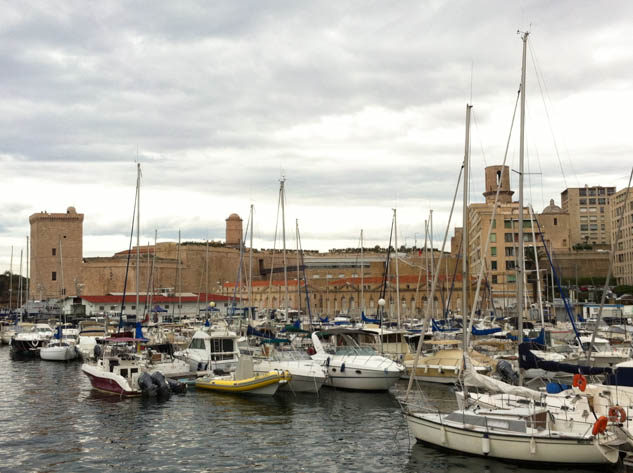
Vieux Port
Last but not least, visiting the Vieux Port is one of the best things to do in Marseille. Literally meaning old port, this is where lies the true soul of the city and where it was born 28 centuries ago. Set in this colorful location, fishmongers sell their daily catch along the boat-lined quay of Quai de La Fraternité every morning from 8am until 1pm. As a matter of fact, foodies claim that the bouillabaisse in this very fish market (Marché aux Poissons or La Criée) is truly authentic!
Furthermore, you can easily board a boat from the Vieux Port to discover the nearby inlets (calanques) and islands dotting the Mediterranean Sea (such as the Frioul islands featuring the imposing Château d’If pictured in Dumas´novel ´The Count of Monte-Cristo´).
What and where to eat in Marseille (France)
Typical dishes from the Provençal cuisine
Given its strategic location in the Provence–Alpes–Côte d’Azur region, Marseille is a good spot to try the Mediterranean food, offering fresh and varied farm-to-table ingredients.
For your ease of reference, I’ve sorted by category the most traditional typical dishes from Provence (cuisine provençale) you will likely find in Marseille and elsewhere in the region:
- Starters: fougasse (type of bread typically resembling a head of wheat that can contain anchovies, olives, onion and herbes de Provence such as basil, rosemary or thyme), pissaladière (flatbread similar to a pizza with anchovies, olives and onions that can be served either hot or cold), ratatouille (stewed vegetables and Provençal herbs cooked in tomato sauce), salade niçoise (traditionally made of anchovies, hard-boiled eggs, olives, tomatoes and tuna), soupe au Pistou (vegetable soup with beans and pesto).
- Fish: bouillabaisse (fish and seafood stew originating from Marseille; this traditional recipe is usually served in two rounds: first you eat the fish soup along with toasts and a mayonnaise with spices known as rouille, and then you eat the fish).
- Meat: daube de boeuf (slow-simmered beef stew in red wine).
- Sauces: aïoli (emulsion of garlic and olive oil), tapenade (spread of puréed olives, capers and sometimes anchovies). Locally produced olive oil and honey are very popular in the region too.
- Desserts: tarte au citron (this lemon tart is typical from Menton, in the Cote d’ Azur).
- Drinks and infusions: crème de cassis (this dark liquor made from blackcurrants can be served on its own or as part of a cocktail), pastis (anise-based liquor), teas with Provencal herbs such as chamomile, lime blossom or verbena.
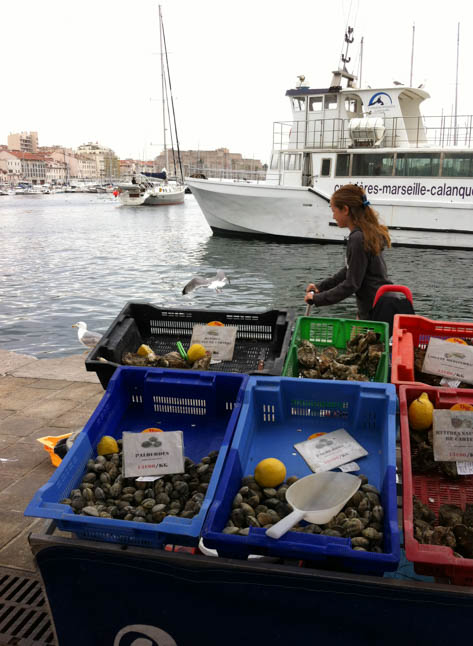
Where to eat in Marseille
When visiting the city, one of the top things to do in Marseille is taste its traditional Provencal cuisine featuring delicious Mediterranean products. While the Old Port (Vieux Port) of Marseille is known for its waterfront cafes and seafood restaurants, you can find excellent bistrots along Rue Sainte. For late-night bars and clubs, head near the Opéra de Marseille.
- ☕ Bistrots, brasseries and cafes: Bistrot l´Horloge, Brasserie Le Carré, Coin Coin, Four des Navettes (selling ´navettes´-boat-shaped biscuits scented with orange blossom- since 1781), La Samaritaine (brasserie operating near the Old Harbor since 1910), Le Rhinocéros, Vertigo Bar Food (it is part of the Vertigo youth hostel).
- 🍽️ Restaurants: Bar Nautic Restaurant (with outdoor seating in the nearby Calanque de Morgiou), Chez Yassine (Tunisian cuisine), La Délicatesse (serves traditional fish and meat dishes), L’Épuisette (one of the best restaurants in Marseille, overlooking the charming fishing port of Vallon des Auffes), Le Château de Sormiou (French cuisine in the Calanque de Sormiou), Le Petit Nice (3 Michelin stars), Le Petit Pavillon (on the corniche Kennedy), Le Restaurant de la Basilique Notre-Dame de la Garde (located in the iconic basilica of Marseille, this restaurant offers Mediterranean cuisine along with panoramic views), Les Buffets du Vieux-Port (buffet restaurant with outdoor seating in the Vieux Port offering bouillabaisse or fresh seafood among many other options), Mama Africa (cuisine from Ivory Coast), Miramar (this pricey restaurant ideally located on the Vieux Port is famous for its bouillabaisse and fresh seafood dishes), Peron Restaurant (make sure to order their famous bouillabaisse), Poissonnerie Kennedy (fish market where you can try some fresh oysters or eat at its Onassis restaurant upstairs), Tuba Club.
- 🍦 Ice creams: Vanille Noire (this ice cream parlor became famous for its black vanilla flavor, but there are many others you can try in their various branches, be it in Le Panier, near the Opera or in the Vieux Port).
- 🍸 Bars and clubs: R2 Le Rooftop des Terrasses (panoramic views over the port and live music with DJs), Back to BAC (karaoke bar), Carry Nation (speakeasy), Les Berthom (beer garden with outdoor seating).
Do you like my content? Subscribe to my newsletter to stay tuned.
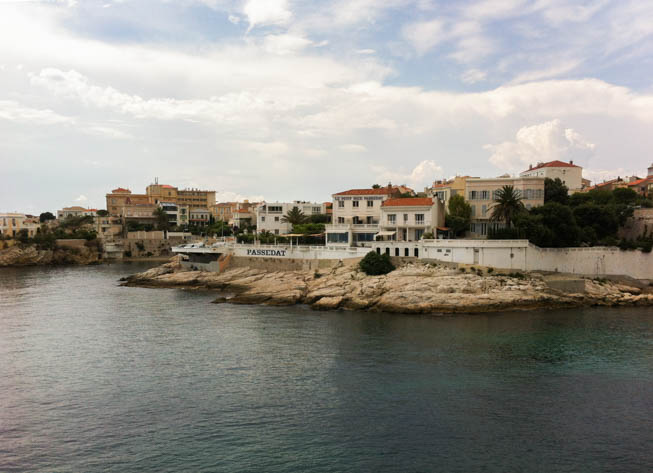
Where to stay in Marseille, France
Unsurprisingly, as the second largest city in France, Marseille offers a vast number of accommodations for all budgets, from affordable hostels to charming boutique hotels or more upscale hotels.
If you’re wondering where to stay in Marseille, here’s a selection of the best accommodations sorted by budget:
- Luxury hotels in Marseille (💰💰💰): Château de Cassis (located in Cassis, around 30 minutes away from Marseille), Hôtel Dieu Intercontinental Marseille (once a former hospital, this luxurious hotel now also houses a spa), Le Petit Nice Passedat (5-star boutique hotel by the sea), Sofitel Marseille Vieux Port (it offers an unrivaled view of the Vieux Port and also has a spa).
- Medium range hotels in Marseille (💰💰): Citadines Apart’hotel Prado Chanot Marseille (fully-equipped apartments with kitchenette), Hôtel Balladins Marseille (where we stayed during the work trip), Hôtel Edmond Rostand, Hôtel Peron (family-run hotel on corniche Kennedy with a famous restaurant serving the traditional bouillabaisse), Mama Shelter Marseille, Maisons du Monde Hôtel & Suites – Marseille Vieux Port (unique hotel by the famous French decoration brand), Radisson Blu Hotel Marseille Vieux Port (features a panoramic pool), Tuba Club (boutique hotel also housing a restaurant).
- Budget accommodation in Marseille (💰): B&B Hotel Marseille Euromed, ibis budget Aéroport Marseille-Provence, Pension Edelweiss, Pitchounette and Olives, The People Hostel – Marseille, Vertigo Hostel Vieux-Port (they have a food bar as well).
For more accommodation options in Marseille (France), feel free to check out Airbnb or Booking, my go-to platforms wherever I travel around the world.
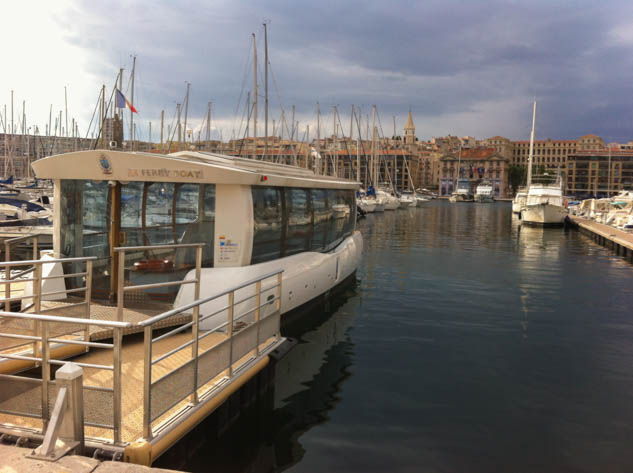
How to get around Marseille
You can use various modes of transportation to get around Marseille, each offering a different experience of the city. Marseille is also ideally connected to other destinations, both in the nearby Cote d’ Azur, around France, across Europe or further abroad.
Let’s see what are the best ways to get around Marseille:
- 🚲 By bike: the city has a bike-sharing program called ‘levélo‘ , which offers a convenient way to rent a bike for short trips around town. There are also dedicated bike lanes in many parts of the city.
- 🛥️ By boat or ferry: take the Ferry Boat for a short crossing connecting the Quai du Port and Quai de Rive Neuve while admiring the Marseille Marina in the Vieux Port. If you wish to explore the Mediterranean coastline, the nearby calanques, the Frioul archipelago or the Château d’If, you can take a boat tour from the Vieux-Port with Le Bateau. This is for sure one of the best things to do in Marseille! The MPCT – Marseille Provence Cruise Terminal is located in the port area. Indeed, a number of ferries depart from the maritime hub of Marseille, connecting the city with other destinations such as Algeria, Corsica, Morocco or Tunisia.
- 🚌 By bus, tram or metro: Marseille has an extensive public transportation system that includes buses, trams, and a metro. The Régie des Transports Métropolitains (RTM) operates these services, and you can use a single ticket for all modes of transport. You can browse the map to decide which line works better for you. Another great way to discover the city is by boarding a tourist train (le petit train touristique) or hoping on and off a tourist bus. In case you´re traveling to another destination further away, you may take a bus from the Gare Routière, next to the Marseille Saint-Charles train station.
- 🚙 By car: renting a car at the airport or in the city can be useful if you plan to visit areas outside of Marseille (say, the glitzy Cote d’ Azur) or if you prefer to travel at your own pace. However, traffic and parking can be challenging in the city center. In any case, note that Marseille is well connected to other French destinations through highways known as autoroutes, such as A7 to Lyon, A50 to Toulon, or A51 to Grenoble to name a few.
- 👣 By foot: Marseille’s city center is walkable, and strolling through its streets allows you to appreciate the local architecture, shops, and cafes at a lower pace. Areas like the Vieux-Port (Old Port) and Le Panier are particularly pedestrian-friendly. A good idea is to book a free walking tour around Marseille. That being said, some others require walking up particularly steep hills (think reaching the Notre-Dame de la Garde basilica for example, although public transportation alternatives are always available).
- ✈️ By plane: the Marseille Provence Airport is located about 25 km northwest of the city and is accessible by public transport, taxi, or car. This international airport connects with plenty of destinations around the world, including Africa, Europe, the Middle East or North America.
- 🚕 By taxi: taxis in Marseille are readily available, and ride-sharing services such as Bolt, Sixt or Uber operate in the city, offering a more private way to travel.
- 🚂 By train: Marseille Saint-Charles is the train station (gare) in the city. From there, you can easily catch a train to other French destinations such as Lyon (in just two hours) or Paris (four hours).
Consider getting the Marseille City Pass for discounts and good deals during your stay, be it 24h, 48h or 72h.
Feeling adventurous? Check out these outdoor activities with Manawa in Marseille.
Day sailing cruise around Marseille
Guided Hike in Calanque de Sormiou, Marseille
Sea kayak excursion to Cap Croisette and sunset in the Calanques of Marseille
Via ferrata in the Calanque de Sormiou near Marseille
Marseille map
For your ease of reference, below you will find a Marseille map with all the spots mentioned throughout this blog post. Make sure to save it so you can plan your next trip in a breeze!
Day trips from Marseille
There are certainly many things to do in Marseille. But in case you feel like exploring beyond this bustling French city, you’ll be thrilled to learn that you can find endless dreamy destinations in the Provence–Alpes–Côte d’Azur region, from idyllic Mediterranean coves to charming villages in the countryside.
Here are some options if you’re considering a day trip from Marseille. For your ease of reference, I’ve listed the counties west to east, starting from the closest to Marseille to the furthest: Bouches-du-Rhône, Var, Alpes-Maritimes.
Bouches-du-Rhône
This county (département in French) is the one Marseille belongs to, and as others in the Provence–Alpes–Côte d’Azur region, it features a great mix of coastal destinations by the beach and more tranquil spots inland.
A few places worth visiting in the French countryside in Bouches-du-Rhône include:
- Aix-en-Provence: as the birthplace of painter Paul Cézanne, this charming enclave houses a number of artistic treasures, such as the cathedral (Cathédrale Saint-Sauveur), Cézanne’s atelier, Musée Granet, the Pavillon Vendôme or the tapestry museum (Musée des Tapisseries). Stroll through the Old Town (Vieil Aix), Quartier Mazarin and Parc Jourdan while soaking up the beauty of the charming avenues and streets lined up with endless fountains.
- Arles: this city has preserved many Roman remains such as the Amphitheatre (Arènes d’Arles), the Roman Theater (Théâtre Antique), or the magnificent cloisters housed in the church dedicated to Saint-Trophime. Les Alyscamps, a former Roman necropolis, served as an inspiration for Gauguin and Van Gogh. The nearby Abbey of Montmajour is worth a stop too.
- Les Baux-de-Provence: medieval citadel on a rocky plateau featuring some landmarks such as the Yves Brayer museum, the Cathédrale d’Images (an arts theater housed in a former bauxite mine) or a church built in the 12th century (église de Saint-Vincent).
- Saint-Rémy-de-Provence: often referred to simply as St-Rémy, this charming village featuring boulevards lined up with trees, narrow streets and tranquil fountains is well known for the Roman archaeological site of Glanum and for having welcomed Van Gogh between 1889 and 1890.
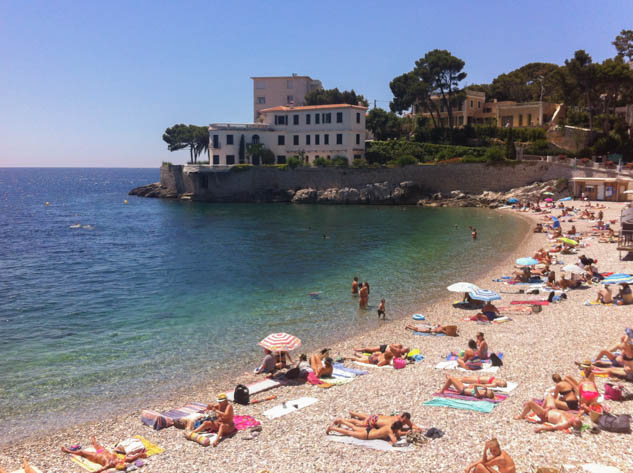
On the other hand, you could visit the following breathtaking locations along the Mediterranean coastline in Bouches-du-Rhône while you drive on the coastal roads (corniches):
- Calanques National Park (Parc National des Calanques): connecting Marseille to Cassis on a 20-km stretch, the white, dry cliffs loom over coves and inlets known as Calanques of dazzling turquoise waters. This is a popular getaway destination for local Marseillais, who come here to have a snack, hike the various trails, kayak skirting the coastline or snorkel. Some of their favorite calanques include Calanque de Morgiou, Calanque de Port-Miou, Calanque de Sormiou or Calanque d’en Vau. To get here from Marseille, you can also bike, take a bus or a sea shuttle. However, note that driving is not recommended because parking is rare and unguarded.
- Cassis: this popular tourist destination lies at the end of the Calanques mentioned above. Nestled at the foot of a spectacular cliff crowned by a 14th century château (now converted into a hotel – Château de Cassis), the charming coastal town of Cassis features an active port surrounded by pastel buildings as well as welcoming cafes and restaurants where you could taste fresh seafood, the Cassis local wines (white or rosé) or the crème de cassis (a dark liquor made from blackcurrants). Make sure to lie down in the pebbly beaches such as Plage du Bestouan to enjoy the Mediterranean lifestyle at its best!
- Îles du Frioul: this archipelago near Marseille comprises four islands, namely Pomègue, Ratonneau, Tiboulen, and If. The latter is the most famous one because of Dumas’ novel ‘ The Count of Monte-Cristo’ and was used as a prison (it would be the equivalent of the infamous Alcatraz in San Francisco). Visiting the Frioul islands is a popular day trip from Marseille since they can be easily reached by boat.
- La Camargue: this natural park (Parc Naturel Régional de Camargue) is located between the Mediterranean Sea and the two arms of the Rhône river delta. In it, you will be able to spot flamingos, black bulls and the iconic white horses. The flavorful sea salt is the most famous product from Camargue.
- La Ciotat: this elegant city is worth a detour thanks to its various landmarks, from the botanical garden (Parc du Mugel) and its iconic Old Port area, to the Musée Ciotaden or the Eden Theater, the world’s oldest operating cinema.
- Martigues: this cute destination is known as the Provencal Venice thanks to its charming canals and picturesque port of Miroir des Oiseaux that remind the famous Italian city.
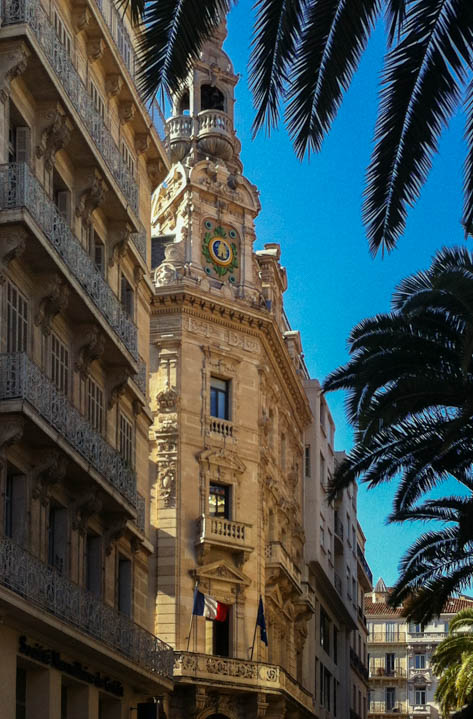
Var, Alpes-Maritimes and Vaucluse
Next to the Bouches-du-Rhône county, the Var area in the Provence–Alpes–Côte d’Azur region features both charming places along the coastline as well as tranquil villages in the countryside. Some worth mentioning include Saint-Tropez or Fréjus on the glamorous French Riviera, although stopping by Massif des Maures or Parc naturel régional du Verdon are worthwhile too.
On the other hand, the coastline along the Alpes-Maritimes county bordering Italy to the east is the true heart of the glitzy French Riviera, known as Côte d’Azur in French. Some coastal destinations here include Cannes, Antibes, Nice, Monaco (although it’s an independent microstate) or Menton. If you wish to head inland, Biot, Gorges du Loup, Grasse, Peille, Peillon, St-Paul-de-Vence or Vence are some of the locations worth exploring in Alpes-Maritimes.
Cote d’Azur: 7 places to visit along the French Riviera from St-Tropez to Menton
Finally, other places near Marseille worth considering for a day trip include the county of Vaucluse, featuring the beautiful cities of Avignon and Gordes for example.
How did you like this travel guide detailing the top things to do in Marseille, what and where to eat, where to stay and also offering some day trip ideas? I hope that the Marseille map was helpful too!
In case you have any questions or comments, please don’t hesitate to share them below.
***
✈️ Curious to know where I’ll be traveling next? ✈️
Stay tuned by following me on social media (Facebook, Instagram, X) and subscribe to my newsletter for regular updates!
In the meantime, safe travels around the world!
***
| GET READY FOR YOUR NEXT TRIP! |
|---|
| Browse my travel resources page to plan your upcoming trip. |
| Feeling adventurous? Book any outdoor activities worldwide with Manawa! |
| Get medical or health insurance via SafetyWing for extra peace of mind. |
| Looking for sports equipment? Feel free to browse my Decathlon profile for inspiration. |
| Use the Anaya Touring or Lonely Planet travel guidebooks to plan your trip. They’re really comprehensive and helpful! |
| Create travel memories you’ll never forget! Book things to do, attractions and tours around the world with Get Your Guide. |

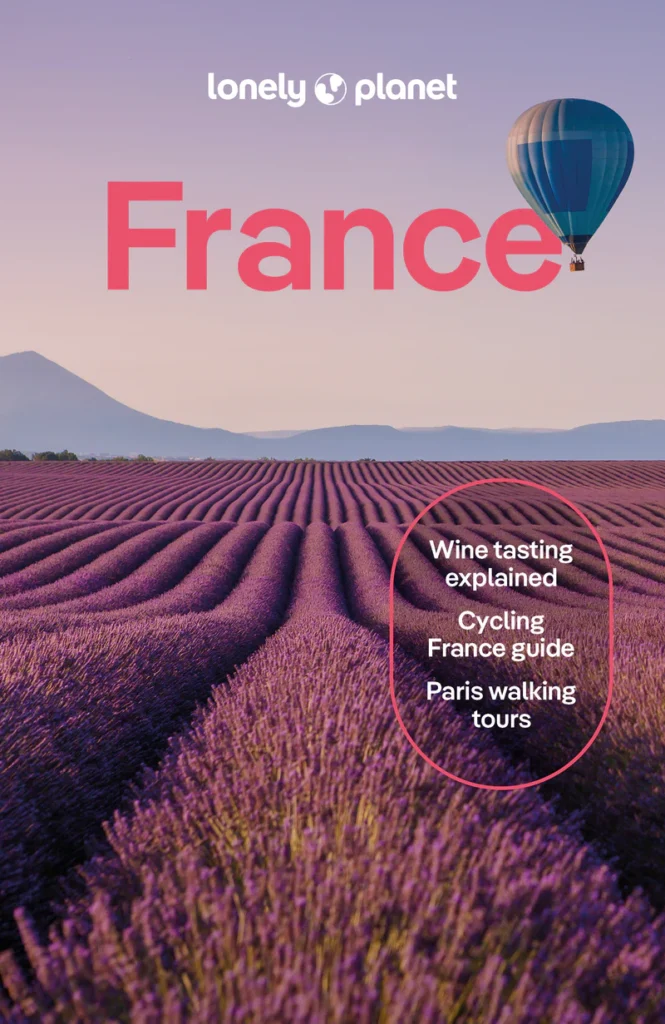
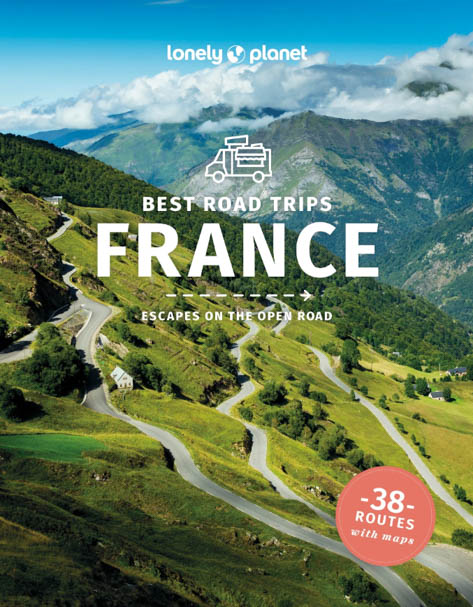
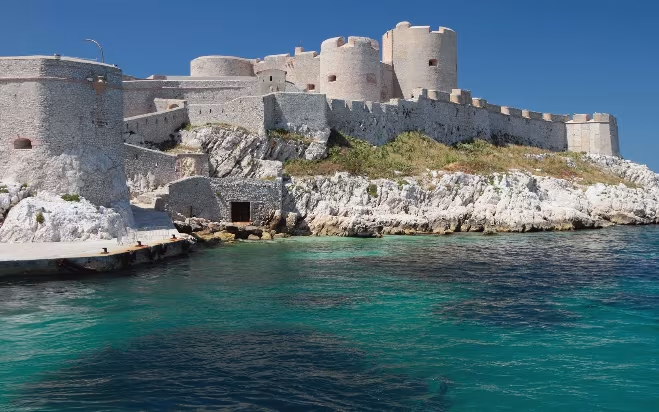
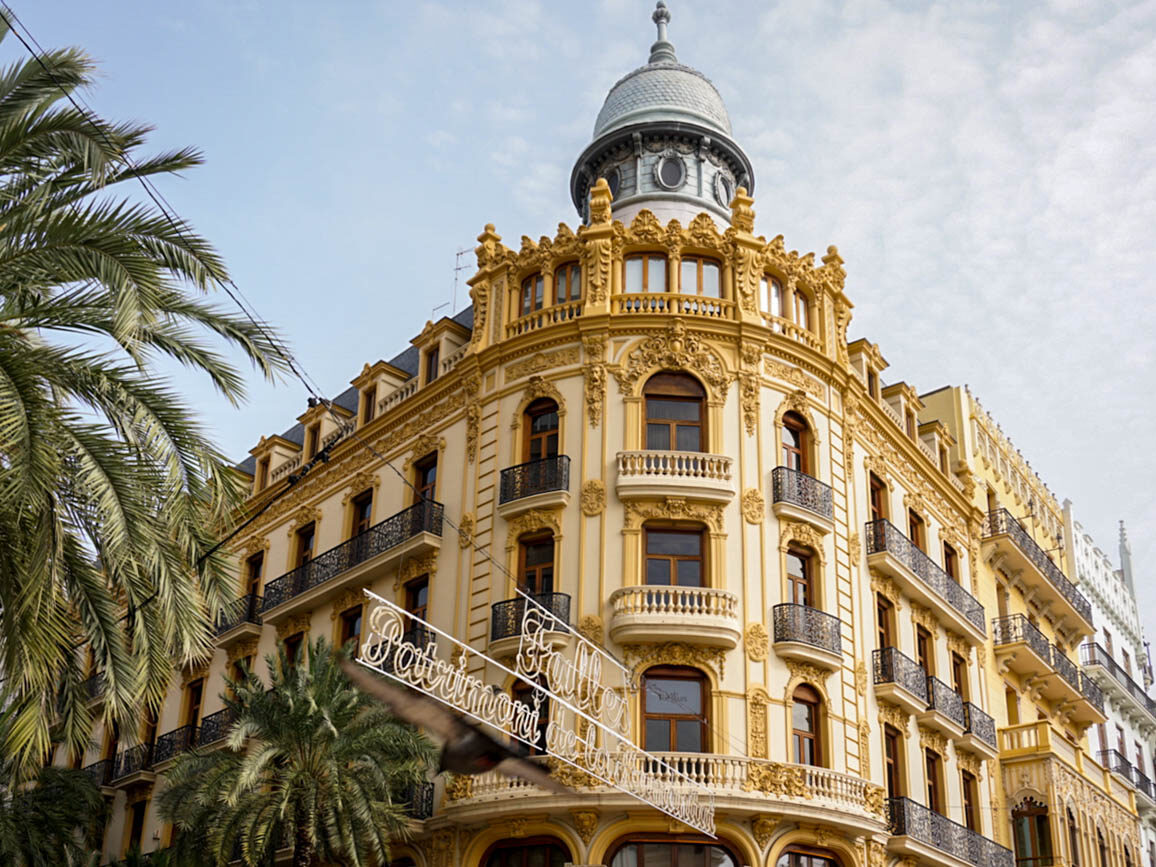
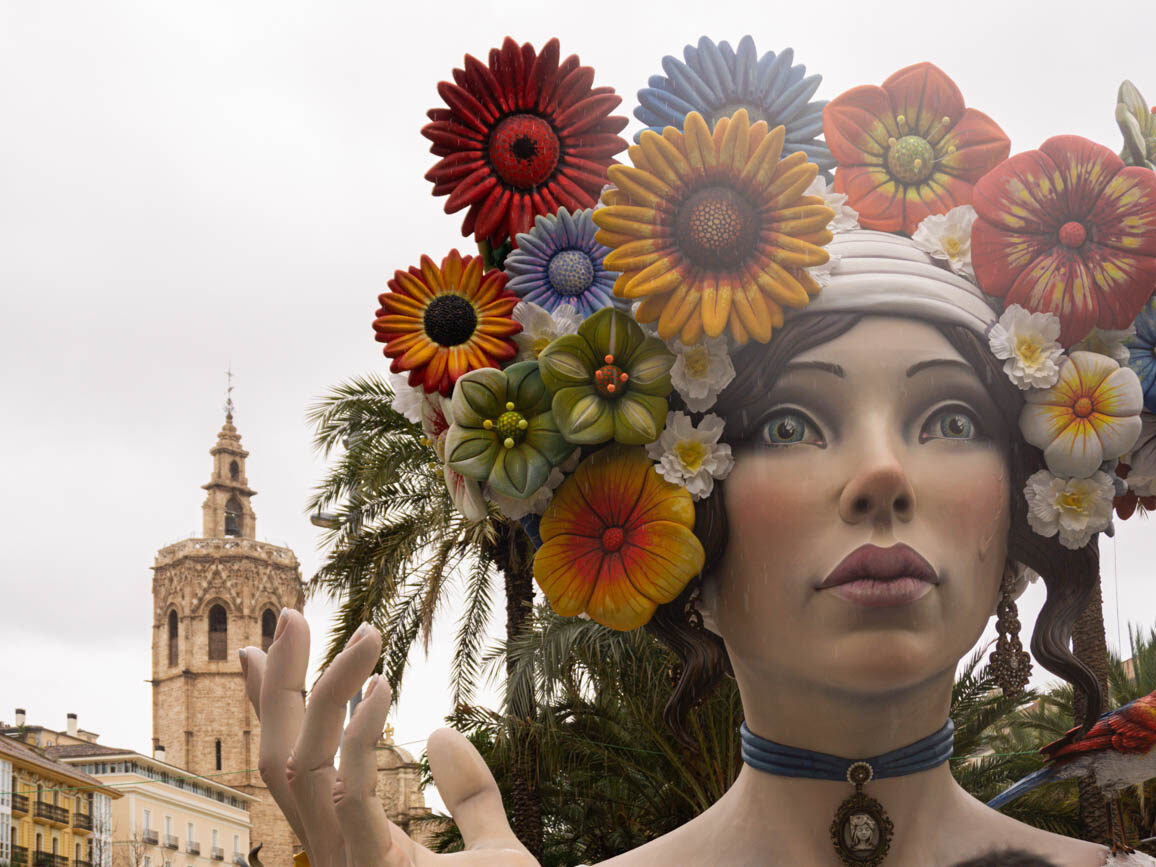
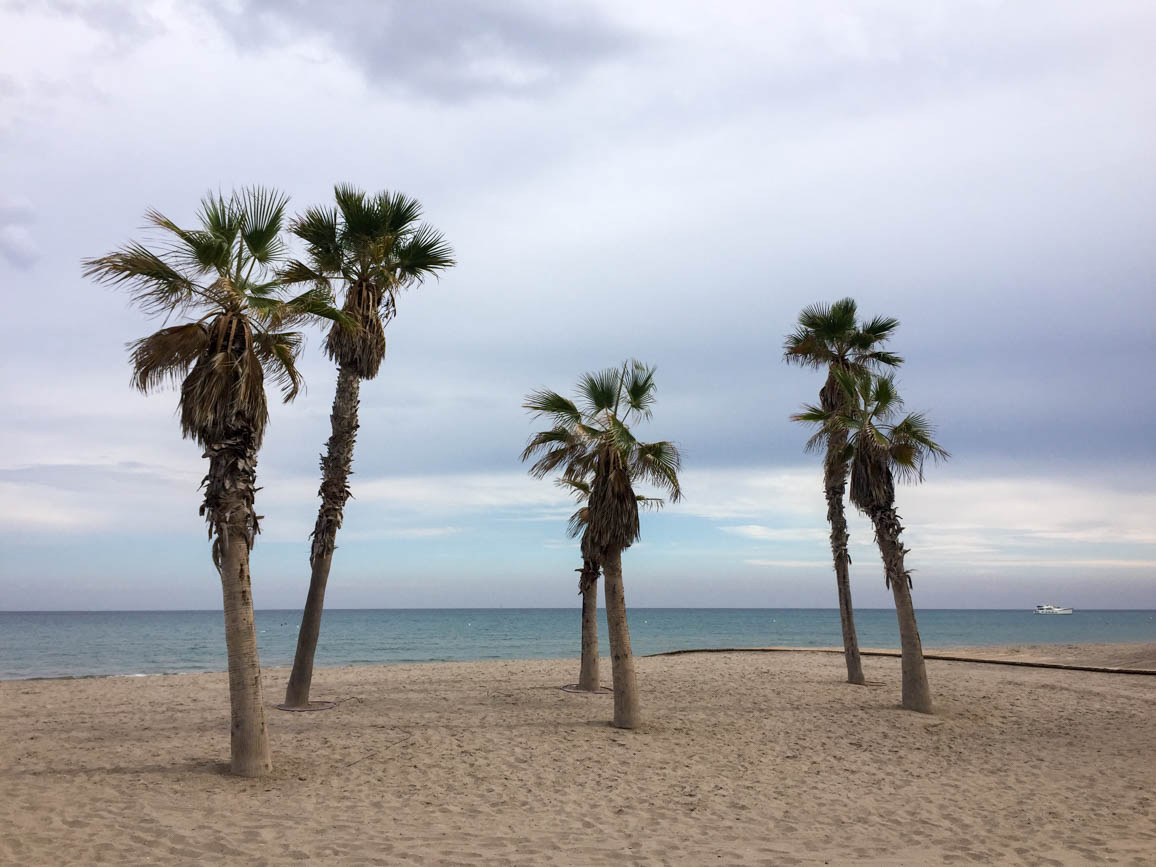
Freddie
This is such a fantastic list of things to do in Marseille! I love how you’ve included a mix of cultural sites, scenic spots, and local experiences—it really helps travelers get the best of the city. The tips on where to eat and explore are super helpful too. Thanks for sharing this wonderful guide!
Mariela
Dear Freddie, thanks for your kind comment and I´m glad that you enjoyed this comprehensive Marseille travel guide. Have you already visited the city or are you planning to do so soon? Please let me know how it goes and feel free to subscribe to stay tuned!